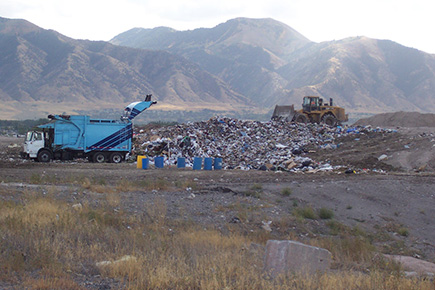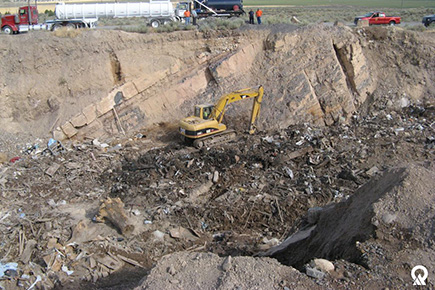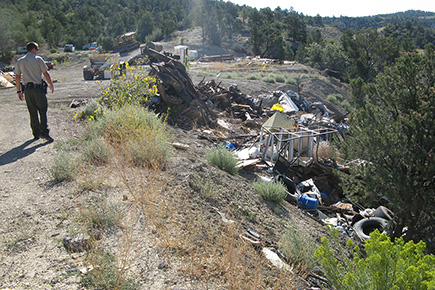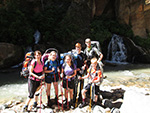Interview with Matt Sullivan

Most of us take our trash to the curb for pickup and don’t really consider where it goes after that. But did you know that the landfill that accepts your trash has to meet and maintain rigorous environmental standards to protect soils, ground water, and air? We asked Matt Sullivan, an environmental scientist with the Division of Waste Management and Radiation Control, to give us an inside look at the world of landfills, an often overlooked but essential part of our waste disposal stream.
What is a landfill?
A landfill is a permitted waste disposal facility that is designed to protect the environment from the contaminants produced by solid waste. Landfills must meet strict siting criteria and be located away from wetlands, faults, residential areas, schools, airports, archaeological sites, floodplains, wells, and springs. Most people understandably don’t want to live near a landfill, which makes finding suitable locations more difficult.
Are there different types of landfills?
Yes. A typical Class 1 Landfill in a large city receives more than 20 tons of waste per day, while a small town/rural landfill that receives less than 20 tons per day is a Class II Landfill. These municipal solid waste (MSW) landfills accept everything, including small quantities of household hazardous waste. Construction and demolition (C&D) landfills take construction waste such as concrete, wood, asphalt, drywall, metals, bricks, and plumbing fixtures.

Who runs landfills?
Landfills are generally owned and operated by municipalities, although some landfills are privately owned. Landfill owners and operators have a strong land stewardship ethic and take great pride in their ability to manage waste appropriately from cradle to grave.
What happens to my trash after it’s picked up by the garbage truck?
Most likely, your waste goes to a transfer station if you live along the Wasatch Front. There, some wastes, such as electronic waste, plastics, metals, and tires are diverted to recyclers. Green waste is sent to be composted. The rest is transferred to semi-trailer trucks for disposal at the landfill. The waste is brought to the base of the working face of a landfill cell and dumped out. Large, heavy compactors spread the trash out 50 to 60 feet wide, then compact it in place. As new waste arrives, it is spread and run over by the compactors then worked-in and pushed up the cell slope (working face). At the end of the day, the waste is covered with 6 inches of soil or a spray similar in consistency to papier-mache to keep the trash from blowing away. Compacted cells of trash are eventually built up in a pyramid shape to optimize landfill air space.
How do landfill operators protect the environment?
The permits DEQ issues to landfills contain strict environmental requirements. New or expanded landfills must use a liner to prevent ground water contamination. The liner can be made of different materials, but it is usually made of a plastic geomembrane that overlays approved engineered soil. A leachate (contaminated liquid) collection and removal system sits between a permeable and non-permeable liner where it collects contaminated water (leachate) that has percolated through the waste. Leachate is then properly treated once it is collected. Runoff and run-on from the waste piles is managed under a Stormwater Pollution Prevention Plan (SWPPP). Landfills channel their runoff into a detention pond for treatment to prevent contaminated water from reaching nearby streams or soils. Ground water wells set up along the perimeter of the landfill monitor water quality
What about the methane gas that builds up in landfills? How is that handled?
Methane emissions from landfills are a significant air quality issue. As the waste decomposes, a primary gas, methane, is produced. Landfills are required to monitor for methane gas, and if it exceeds air quality standards, they are required to either flare it or use a methane capture system. Many landfills have recognized the onsite electric generation possibilities from methane gas and developed gas collection systems that clean the gas for use as an energy source. The Trans-Jordan landfill, for example, teamed with Granger Energy and Murray City to use methane gas produced at the landfill to power over 3,000 homes with electricity generated by landfill gas (LFG).

Do you ever have to deal with illegal dumping?
Sometimes landowners or small rural areas create de facto dumps on private or public lands.In these instances, we work with local law enforcement and the local health departments to create working relationships with the dump owners and explain the need for proper waste treatment and disposal. Usually, the landowners will clean the dumps up themselves. Small permitted rural landfills do a good job of managing solid waste, and we direct illegal dumpers to dispose of their trash at these permitted facilities.
What do you like most about your job?
I get to work with some great people and travel to various parts of the state. I enjoy working with landfill owners to help them better understand their piece of the waste puzzle so they can manage their facilities properly. Projected growth and development in Utah means responsible ownership and practices of waste diversion and disposal will become even more important. It’s great to play a role in working with people of all walks of life in this industry to protect our quality of life and our great outdoors that so many Utahns enjoy.
Want to learn more about solid waste disposal? Most large landfills offer free tours and presentations. Check out the Trans-Jordan, Salt Lake County, Wasatch Integrated, and Bountiful landfills or the Salt Lake County, Weber County, North Pointe (Lindon/Springville) transfer stations for more information. Help preserve precious landfill space by separating your recyclables and green waste from your household garbage. Look for products that use minimal packaging materials and reuse or donate items rather than placing them in the trash. Together, we can help reduce waste and protect the environment.

I grew up in Hemet, California, and graduated in Geology Engineering from Brigham Young University. I have worked for DEQ for 24 years after a few years in environmental consulting. My family and I enjoy all four seasons the great outdoors has to offer.

